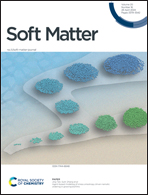A bio-inspired co-simulation crawling robot enabled by a carbon dot-doped dielectric elastomer†
Abstract
Flexible actuation materials play a crucial role in biomimetic robots. Seeking methods to enhance actuation and functionality is one of the directions in which actuators strive to meet the high-performance and diverse requirements of environmental conditions. Herein, by utilizing the method of adsorbing N-doped carbon dots (NCDs) onto SiO2 to form clusters of functional particles, a NCDs@SiO2/PDMS elastomer was prepared and its combined optical and electrical co-stimulation properties were effectively harnessed to develop a biomimetic crawling robot resembling Rhagophthalmus (firefly). The introduction of NCDs@SiO2 cluster particles not only effectively improves the mechanical and dielectric properties of the elastomer but also exhibits fluorescence response and actuation response under the co-stimulation of UV and electricity, respectively. Additionally, a hybrid dielectric elastomer actuator (DEA) with a transparent SWCNT mesh electrode exhibits two notable advancements: an 826% increase in out-of-plane displacement under low electric field stimulation compared to the pure matrix and the ability of NCDs to maintain a stable excited state within the polymer for an extended duration under UV-excitation. Simultaneously, the transparent biomimetic crawling robot can stealthily move in specific environments and fluoresce under UV light.



 Please wait while we load your content...
Please wait while we load your content...